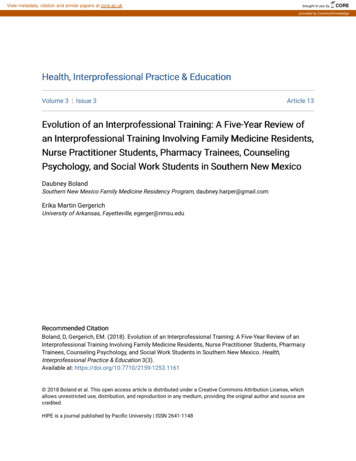
Transcription
Journal of Interprofessional Education & Practice 17 (2019) 100286Contents lists available at ScienceDirectJournal of Interprofessional Education & Practicejournal homepage: www.elsevier.com/locate/jiepSocial workers on the interprofessional integrated team: Elements of teamintegration and barriers to practiceTLisa D. Zerdena, , Brianna M. Lombardib, Erica L. RichmancaUniversity of North Carolina at Chapel Hill, School of Social Work, United StatesUniversity of Pittsburgh, School of Social Work, United StatescUniversity of North Carolina at Chapel Hill, Cecil G. Sheps Center for Health Services Research, United StatesbA R T I C LE I N FOA B S T R A C TKeywords:Social workSocial workersInterprofessional practiceIntegrated healthBehavioral healthRoles for social workers on integrated health teams are growing, yet more information is needed to understandthe workings of interprofessional teams and their practice settings. Even less is known about the barriers topractice social workers encounter or the system-level factors that promote or inhibit social workers’ success asmembers of interprofessional, integrated teams. This article presents findings from a study of 395 social workerswho are members of interprofessional teams in integrated health care settings across the country. Discussionincludes the characteristics, clinic types, and populations served are explored. Additionally, the discussion includes the common elements of team integration and clinic- or system-level barriers that affect social workpractice in integrated, interprofessional settings. We offer recommendations for educational, practice, and policyefforts to better support integrated care, interprofessional teams, and integration across health systems.The roles of social workers are increasingly expanding, particularlyfor social workers practicing as members of integrated health careteams.21 These new roles are responsible for an increasing number ofsocial workers in health care settings, a workforce that is expected togrow by 20% over the next 10 years.26 Primary factors spurring thegrowth of social work in integrated health include the shift in healthsystems toward prioritizing patients’ behavioral health and increasedunderstanding of the ways in which the social determinants of healthaffect physical health outcomes.21 To meet these changing needs, thesocial work workforce brings unique knowledge and skills to integratedhealth settings that make social workers valuable members of interprofessional teams.9,27 For example, as members of interprofessionalteams, social workers bring an understanding of psychosocial risk andprotective factors, behavioral health screening, assessment and intervention, and the skills to adapt services to be culturally inclusive.28Although the literature supports the expanding roles of social workerson integrated health teams,9 only limited literature has examined theinterprofessional teams and characterized the integrated practice settings in which social workers are employed. Further, little is knownregarding the barriers to practice that social workers might encounterwhen working as members of interprofessional teams in integratedhealth settings.The addition of social workers to integrated health teams has required health systems to include members not traditionally considered as members of the health care team. Expanding the idea of who “belongs” on an integrated health team can occur through interprofessionalefforts in educational and practice settings. IPE is commonly defined asan educational approach in which students or providers from “two ormore professions learn with, about, and from each other to enable effective collaboration and improve health outcomes”25; p.7). Interprofessional practice (IPP) involves more than a mix of professionalsworking together; IPP represents a fundamental rethinking of healthcare in which providers from different disciplines work collaborativelyand partner with the patient (and the patient's family) to achieve bestoutcomes. IPP is distinct from the older concept of multidisciplinaryteams in which providers from different medical specialties focused onthe same patient but tended to work in parallel and independently(Institute of Medicine, 1972; Grumbach & Bodenheimer, 2004; SchuetzMann & Everett, 2010). In contrast, a critical aspect of IPP centers onthe collaboration being a “negotiated agreement between professionals,which values the expertise and contributions that various healthcareprofessionals bring to patient care”30; p.2). The expansion of integratedcare has focused efforts on using an interprofessional perspective inhealth care education and training so that providers are better able toholistically meet the complex needs of patients and better prepared forthe realities of team-based care.The definition of integrated care has been explained by many healthentities, including the24; which describes this approach as “theCorresponding author. 325 Pittsboro Street, CB#3550, Chapel Hill, NC, 27599-3550, United States.E-mail address: lzerden@email.unc.edu (L.D. Received 18 April 2019; Received in revised form 23 July 2019; Accepted 6 September 20192405-4526/ 2019 Elsevier Inc. All rights reserved.
Journal of Interprofessional Education & Practice 17 (2019) 100286L.D. Zerden, et al.BHWET program, and provided a link to the online survey. As a participation incentive, the invitation informed recipients a 100 gift cardwould be awarded to respondents randomly selected from those whocompleted the survey.Of the 62 HRSA-funded BHWET schools, more than 50% of theproject directors forwarded the recruitment e-mail. However, given thisrecruitment strategy, the exact number of invitation e-mails forwardedis unknown. This study was reviewed and approved by the InstitutionalReview Board at both the University of Michigan and the University ofNorth Carolina at Chapel Hill.management and delivery of health services so that clients receive acontinuum of preventive and curative services, according to their needsover time and across different levels of the health system” (p. 1). Careintegration occurs when multiple services, including primary care,mental health, and substance use services are provided in a comprehensive, coordinated way to produce beneficial and cost-effective delivery of care for people with multiple needs (SAMHSA-HRSA, n.d.). Inintegrated care practices, patients receive comprehensive, personalized,and patient-centered care that not only encompasses mental, physical,and behavioral health conditions but also considers the impact of socialfactors to improve outcomes and increase access to holistic healthservices.21,28 Moreover, the evolution of integrated care models hasbeen supported by increased understanding of the social determinantsof health. An ever-growing body of evidence has shown that socialfactors and experiences such as income, employment, discrimination,and educational attainment influence mental, physical, and behavioralhealth outcomes.3,4,16 Given these complex, interrelationships, integrated health care is understood as a transformative model of carethat breaks down the traditional siloed, fractured systems to betteraddress co-occurring chronic disorders10 and can be adapted specifically to the social work profession.29 The integrated care approach requires an interprofessional team of providers who can coordinatetreatment plans and collaborate to comprehensively treat individualconsumers and address their multiple needs holistically.Social work, one of the largest groups of clinically trained providersin the United States,17 are trained in a systems-perspective predicatedon serving society's most vulnerable, marginalized, and underservedgroups. Social workers can provide a crucial perspective for interprofessional teams that want to improve health equity, address thesocial determinants of health, and adapt behavioral health caremethods (e.g., screening, assessment, and treatment) to meet consumers' needs in traditional primary care settings.9 Although socialworkers are increasingly part of integrated healthcare teams,9,12 littleinformation is available to explain how adding social workers to interprofessional teams can affect team functioning.18 Even less is knownabout the individual- and system-level factors that promote or inhibitsocial workers' success as members of interprofessional, integratedteams.To address these gaps in the literature, we conducted a study of 395social workers who are members of interprofessional teams in integrated health care settings located across the country). The study hadthree aims. Study Aim 1 was to characterize interprofessional teamsthat routinely included social workers, identifying the providers withwhom social workers collaborated with most frequently, and describingboth the clinic types and patient populations served by care teams thatincluded a social worker. Study Aim 2 focused on examining interprofessional teams to identify common elements of team integration (asdefined by19 elements of integrated practice.10; Study Aim 3 was toidentify the impact of clinic- and system-level barriers on social workpractice in integrated, interprofessional settings.1.1.1. SurveyAn electronic survey was developed using Qualtrics and administered to MSW students and field instructors (N 395). The surveygathered respondents' sociodemographic information and includedquestions on the respondent's role on the integrated health team, teamcomposition, and barriers and facilitators of interprofessional practice.Additionally, the survey collected data regarding on the patient population, setting type (outpatient/inpatient), location (rural/urban), andelements of team integration (defined as team co-location, communication, access to and use of the electronic health record, collaborationand team culture, and team composition) based on the levels of integration established by SAMHSA-HRSA.10 The survey took approximately 35 min to complete.1.1.2. Survey developmentThe survey was developed using current literature, practitionerexpertise, cognitive interviewing, and feedback from pilot data. Prior tothis study, the survey was pilot tested with a small sample of MSWstudents and their field instructors (N 42; 21 BHWET-funded MSWstudents and their 21 field instructors.7; After pilot testing, the surveytool was refined through cognitive interviewing with four MSW studentinterns working in integrated care settings to better understand howrespondents interpreted each survey item. The instrument was thenreviewed by social workers and nurses with active practices in integrated settings. Survey items about the level of practice integrationwere drawn from SAMHSA-HRSA Center for Integrated Health Solutions Standard Framework for Levels of Integrated Healthcare,10 corecompetencies of integrated care11; and the Integrated Practice Assessment Tool, version 2.023).1.1.3. AnalysisThe survey analysis was completed using Stata 15. Given the exploratory nature of the study aims and the data collected, we conductedboth descriptive and bivariate (t-test and Pearson chi-square) analyses.2. ResultsOf the 395 respondents (64% MSW students, 36% field instructors),the majority were women, and 75% self-identified as White, 10% asBlack, 6.5% as Latinx, and 8.5% as other or multiracial. Sample demographics were consistent with reports of the national population ofMSW students that indicate 80% of MSW students are female5). However, in this national census of MSW students, only 54% identified asWhite as compared with 79% in our sample. Most field instructors inour sample (77%) were licensed clinical social workers (LCSW), with anadditional 8% working toward LCSW licensure. Most field instructorsgraduated from an MSW program in 2009 (mean 2001; SD 10.3;range 1971–2015). Over one-third of MSW student respondents(36%) reported having a bachelor's of social work degree. Not surprisingly, MSW students (M 27.35 years, SD 15.88) were statistically significantly younger than the field instructors (M 42.69,SD 16.79), t(391) 9.0082, p .001). See Table 1 for sample description.Study Aim 1 focused on characterizing the interprofessional, integrated settings and types of providers and composition of the teams1. Method1.1. Sample and participant recruitmentA convenience sample was recruited from a list of schools of socialwork that received funding in 2014 from the Health Resources andService Administration (HRSA) under the Behavioral Health WorkforceEducation and Training (BHWET) initiative. (For information on theBHWET HRSA-funding mechanism, see Ref. 14. To recruit potentialrespondents, our team contacted BHWET project directors with a request that they forward a pre-scripted e-mail to masters of social work(MSW) students and field instructors in their programs. If project directors were unavailable, the research team contacted administrators ofthe identified BHWET schools. The scripted e-mail explained the study'spurpose, included an invitation to participate in a survey of their2
Journal of Interprofessional Education & Practice 17 (2019) 100286L.D. Zerden, et al.Table 1Sample description (N 395).MSW StudentnTotalGenderMaleFemaleOtherAge***Highest DegreeUndergraduateMastersDoctorate (MD or PhD)RaceBlack (non-Hispanic)White emic hospital systemNon-academic health systemCommunity settingField Instructorn (%) or Mean (SD)n251246251251Total Samplen (%) or Mean (SD)14213724 (9.76%)219 (89%)3 (1%)27 (17)142142217 (86%)34 (14%)0n39538315 (11%)122 (89%)043 (16)3933935 (4%)129 (91%)8 (6%)249142183 (74%)26 (10%)15 (6%)25 (10%)3919846 (22%)68 (33%)94 (45%)39 (10%)341 (89%)3 (0.8%)34 (12)222 (56%)163 (41%)8 (2%)113 (80%)13 (9%)4 (3%)12 (8%)208n (%) or Mean (SD)296 (76%)39 (10%)19 (5%)37 (9%)30623 (23%)44 (45%)31 (32%)69 (23%)110 (36%)125 (41%)Note. T-test and Pearson χ2 statistic were used to compare differences across groups.***t(391) 9.01, p .0.001).composition of their interprofessional care team. Most respondentsworked with physicians, specifically identifying primary care physicians (45%), psychiatrists (61%), and specialty physicians (8%). Beyond working on a team with other social workers (91%), respondentsmost often worked with registered nurses (RNs; 62%) and nurse practitioners (NPs; 60%). In addition, an open-ended item allowed respondents to specify team constituents beyond the 18 options on thesurvey; 13% identified other professionals on teams, including childprotective services workers, speech pathologists, teachers or schooladministrators, recreation and vocational specialists, and peer-supportspecialists.Team composition was significantly influenced by setting type andco-location of team members. Social workers working in co-locatedsettings (i.e., two or more services located in the same clinic orbuilding, although those services might not be fully integrated) weresignificantly more likely to work with physician assistants (PA) (χ2(1) 5.73, p .05), NPs (χ2 (1) 16.65, p .001), RNs (χ2(1) 5.35, p .05), nutritionists (χ2 (1) 8.48, p .01), and pharmacists (χ2 (1) 5.13, p .05). Social workers in settings without colocated services were significantly more likely to work with communityhealth workers (χ2 (2) 14.44, p .01). Respondents who worked inco-located settings (t(319) 2.50, p .05) and hospital systems (t(361) 3.76, p .01) worked with a significantly greater number oftypes of team members.on which social workers are most frequently included.2.1. Setting typeMost respondents reported working in outpatient settings (57%)followed by inpatient settings (16%), whereas 12% worked across bothoutpatient and inpatient settings. In addition, respondents indicatedworking in other types of settings that included school-based (13%);residential-inpatient (2%); and care settings for justice-involved patients (2%). Respondents were also asked to identify the type of healthsystem they worked within. More than half of the respondents (58%)worked within a hospital system (university-affiliated, private, or otherhospital) and 42% worked in community-based agencies. Less than onefifth of respondents (17%) reported working in a rural health location.2.2. Patient populationsRespondents reported working with patient populations that represented a mix of insurance statuses. Whereas 82% of respondentsreported their patient populations were most likely to be insured, 73%indicated some portion of their caseload was uninsured. Among insuredpatients, 66% of respondents indicated Medicaid was the most frequentinsurance type. Respondents identified serving a variety of patientswith health and behavioral health conditions. For example, respondentsmost frequently reported that most or all of their patients experiencedpsychosocial stressors (73%), mental illness (64%), depression (48%),victimization (52%), and co-occurring health conditions (37%). Somerespondents worked with patient populations in which most or all werepatients with substance-use disorders (21%), chronic medical conditions (19%), and acute medical conditions (13%). Among our sample,respondents infrequently reported working with patient populations inwhich most or all patients had physical disabilities (5%), neurologicalconditions (4%), and developmental disabilities (3%).2.4. Team integrationStudy Aim 2 focused on elements of team integration established bySAMHSA-HRSA's levels of integrated health care.10 Respondents wereasked to describe the extent to which their practices met the six characteristics of integration: team co-location, communication, EHR use,collaboration and team culture, and team composition.102.4.1. Team co-locationMost often respondents were co-located in the same unit or clinicwith their integrated care team (62%), whereas almost another 15%were co-located in the same building as other members of their team,but located in separate units. In contrast, nearly a quarter of respondents (23%) worked in separate practices in separate buildingsfrom the other providers on their team, indicating a lower level of integration. Social workers who worked in hospital systems (academic2.3. Team compositionAs illustrated in Fig. 1, survey respondents worked on interdisciplinary teams that included a variety of health professionals. Thesurvey listed 18 types of health professionals identified in the literatureas members of some interprofessional care teams: On average, respondents selected seven professions (SD 3.6) representing the3
Journal of Interprofessional Education & Practice 17 (2019) 100286L.D. Zerden, et al.Fig. 1. Types of professionals most likely to work on teams with social worker respondents.respondents working within hospital systems indicated that not all teammembers had access to the same EHR. We found no difference in EHRuse by respondent type (i.e., MSW student vs. field instructor).and non-academic hospitals) were significantly more likely to be colocated with other providers on an interprofessional team than weresocial workers who worked in community-based agencies(χ2(2) 9.66, p .001). Similarly, respondents who worked in inpatient, outpatient, and combined settings also were more likely to beco-located with their team members than with respondents in schoolsor settings in the other category (χ2 (4) 10.39, p .05).2.4.4. Collaboration and team cultureMore than 60% of respondents reported that all members of theintegrated team collaborated on patients' plan of care most or all of thetime whereas less than 4% reported never collaborating as a team onpatient care plans. The level of collaboration was significantly associated with both setting and co-location type. As compared with respondents who worked in community-based agencies, schools, or“other” setting types, respondents who worked in a hospital system (χ2(2) 9.71, p .05) or on a co-located team (χ2 (2) 24.03 p .05)were significantly more likely to report full team collaboration most orall of the time. Responses to items that asked participants to indicate theextent to which team members understood each other's roles indicatedthat 38% of teams had an in-depth understanding of each member's rolewhereas 46% had only a basic understanding of other team members'roles and functions.2.4.2. CommunicationAbout 80% of respondents interacted face-to-face with their integrated care team at least weekly, with more than 42% of respondentsreporting daily interactions with members of the care team.Respondents also indicated they had regular communication (i.e., atleast weekly) with the interprofessional team via e-mail (63%) andphone (44%). In addition, a majority of respondents reported frequentlymeeting as a whole team (68%) and/or frequent meeting with portionsof the team (86%). However, the frequency and type of team communications differed substantially across respondent type, setting type,and co-location status. For example, respondents working in either colocated settings (χ2 (2) 53.28, p .001) or inpatient settings (χ2(4) 24.91, p .001) were more likely to report in-person communication with team members that occurred daily or several times a week.Frequent communication by phone (i.e., daily or several times a week)with the integrated care team was most often reported by respondentswho were field instructors (χ2 (1) 8.55, p .01), those working inhospital systems (χ2 (1) 9.03, p .01), or those working in inpatientsettings (χ2 (4) 23.09, p .001).2.5. Barriers to respondents job or field placementLast, Study Aim 3 focused on identifying barriers to respondents’ jobor field placement settings. Responses to these items were capturedusing the same 5-point Likert scale (never, occasionally, often, very often,always) to measure impact of barriers or facilitators to respondentsfulfilling the roles and functions of their positions. For the remainder ofthis section, all percentages indicate an answer of often, very often oralways. Notably, the vast majority of respondents (85%) reportedfeeling supported in their work or field placement. Most respondentsreported feeling the organizational climate was supportive of socialworker roles in general (80%), social worker roles on the interprofessional team (78%), and considered social workers as a valued memberof the team (85%). Although 77% of social workers reported having aclearly defined role on their team, 37% reported that their role overlapped with other team members.Despite favorable indicators of positive organizational environments, respondents reported barriers to their working effectively on the2.4.3. Electronic health record useRespondents were asked if all members of the integrated care teamhad access to the same electronic health record (EHR). About 53% responded affirmatively, although 15% said team members never used thesame EHR. As compared with respondents who worked in school settings or “other” settings, respondents who worked in co-located settings(χ2(1) 37.78, p .001), within hospital systems (χ2 (1) 17.18,p .001), and in both inpatient and outpatient settings (χ2(4) 18.28, p .01) were significantly more likely to have access tothe same patient EHR as other team members. Notably, some4
Journal of Interprofessional Education & Practice 17 (2019) 100286L.D. Zerden, et al.Table 2Frequency of Reported Barriers to Social Work Practice on Interprofessional Care Teams in Integrated Settings.No reimbursement for consultation between medical providers and social workersDifferences in professional culture/terminology between medical providers and social workersPractice insufficiently informed by social determinants of healthMedical providers lack training in behavioral healthNo designated office space for social workerTeam interactions negatively influenced by hierarchal salary systemSocial worker's caseload is too highSocial worker's role overlaps with roles of other team membersSocial worker has clearly defined role on interprofessional teamOrganizational climate supports social workers on an interprofessional teamOrganizational climate promotes social worker's role and social work interventionsSocial worker role is valued on the interprofessional teamData collected by the social worker is entered into electronic health record and is accessible to all team membersNeverOccasionallyOften, Very Often, 815121322243137262344377778808561workers. Study findings highlight the extent to which social workerswork in interprofessional, integrated services across the United States.interprofessional team (see Table 2). For example, 24% reported professional cultural or terminology differences between medical providersand social workers that negatively affected the social workers’ ability tofunction on the team. Almost 31% of respondents indicated that theirwork setting was insufficiently informed regarding the social determinants of health, and 37% of respondents reported that medical providers on their team lacked adequate training in behavioral health.Nearly 25% of all respondents reported a hierarchal salary system had anegatively impact on equitable team interactions.Respondents identified structural barriers in their work settings thatnegatively affected their ability to fulfill their roles on interprofessionalteams. For example, billing was described as an issue that negativelyaffected the social workers' practice, with than 22% of respondentsindicating their work setting lacked a reimbursement mechanism forconsultation between social workers and medical providers. Physicalspace was also a reported barrier, with more than a quarter of respondents indicating their work setting had no designated office spacefor the social worker. Relatedly, the lack of computer access availabilityof technology impacted social work practice, with less than two-thirdsof social workers reporting they routinely entered information intopatients' EHR for all team members to review. It is unknown if this wasa limitation due to not having an office or computer, or if the socialworkers didn't have privileges for using EHR. Last, almost half of respondents (44%) indicated social work caseloads were too large forsocial workers to carry out their expanded roles on interprofessionalteams.Surprisingly, few of the reported barriers differed by student versusinstructor status, setting type, or co-location. MSW students were significantly less likely to report barriers stemming from professionalculture or terminology differences between social workers and medicalproviders (χ2(2) 9.2, p .05). Both student and field instructors inco-located settings were less likely than other respondents to reportbarriers to their practice related to reimbursement for consultation(χ2(2) 6.49, p .05). Last, social workers in community-basedagencies or in settings without co-located services were less likely thanall other respondents to report collecting information that would beincluded in patients’ medical records (72% in hospital system setting vs.48% in community settings; χ2(2) 19.72, p .05).3.1. Health in communitiesAlthough the majority of respondents worked within a hospitalsystem setting, study findings reflect that integrated and interprofessional care is expanding far beyond hospital systems. Indeed, close tohalf of social workers in this study worked in community settings. Thisfinding likely reflects that health care now includes community contextas well as increasing collaborative efforts of community agencies andhealth systems in new and innovative ways.7 Moving care from hospitals to communities is a priority in population health.6 However, thismove requires innovative models of care that depend on a trained andflexible workforce to not only be present in communities but also beinclusive and reflect the diversity of community context. Certainly,social workers constitute one workforce with the training, flexibility,and experience to work across created “walls” in health systems whilehaving the capacity to collaborate with other providers such as community health workers, peer-support specialists, and public healthworkers to transform health care.3.2. The spectrum of integrationThis study further reflects the significant variation in the components of integration, and that such variation is more the rule than theexception. Indeed, respondents indicated considerable differences incharacteristics of service integration, including co-location, team communication, EHR use, collaboration between team members, and teamculture. Extensive variation was seen in both types of hospital-basedhealth systems and within community-based agencies. For example,even within hospital-based health systems, not all members of the interprofessional team had access to the same EHR. Without a sharedEHR, team communication and coordination might be limited and lesseffective. Moreover, without a shared EHR, understanding what socialworkers document and how they contribute to patient care is likely toremain poorly understood among other members of interprofessionaltreatment teams.As compared with respondents working in hospital-based healthsystems, respondents working in community-based agencies identifiedsignificantly fewer components of integration in place on their interprofessional team. In addition, respondents in community-based agencies were far less likely to be co-located with other providers on theirinterprofessional team, and in turn, communicated with other membersof the team less frequently and were less likely to share EHR records. Ashealth care shifts from hospital-based acute or inpatient settings toambulatory and community-based approaches,8 the level of team3. Discussion and implicationsThis study represented one of the largest surveys of social workers inthe United States who are working in integrated settings. The studyaimed to more fully describe the various settings and compositions ofinterprofessional teams on wh
The roles of social workers are increasingly expanding, particularly for social workers practicing as members of integrated health care teams.21 These new roles are responsible for an increasing number of social workers in health care settings, a workforce that is expected to grow by 20% over the next 10 years.26 Primary factors spurring the










